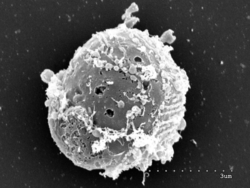Opisthokont
(Redirected from Opisthokonta)
Opisthokonts are a superkingdom of the Eukaryota, including the animals and fungi. It is a group of unikonts.
| Opisthokonta | |
|---|---|

| |
| An animal sperm cell with a posterior flagellum attempts to penetrate an ovum | |
| Scientific classification | |
| (unranked): | Unikonta |
| (unranked): | Obazoa |
| (unranked): | Opisthokonta Copeland 1956,[2] emend. Cavalier-Smith 1987, emend. Adl et al., 2005[3] |
| Subgroups | |
| Synonyms | |
|
Choanozoa sensu Cavallier-Smith | |
There are several classifications of the eukaryotes which are being discussed. Each of them divides the domain Eukaryota into five groups, but there is disagreement on the details.[4]
The Opisthokonta is thought to be a monophyletic clade, and therefore superior to the Unikonta as a taxonomic term.[5][6][7]
| Amorphea |
| ||||||||||||||||||||||||||||||||||||||||||||||||||||||||||||||||||||||||||||||||||||||||||||||||||||||||||||
Opisthokont Media
References
- ↑ Parfrey, Laura Wegener; Lahr, Daniel J. G.; Knoll, Andrew H.; Katz, Laura A. (August 16, 2011). "Estimating the timing of early eukaryotic diversification with multigene molecular clocks". Proceedings of the National Academy of Sciences of the United States of America. 108 (33): 13624–13629. Bibcode:2011PNAS..10813624P. doi:10.1073/pnas.1110633108. PMC 3158185. PMID 21810989.
- ↑ Copeland, H. F. (1956). The Classification of Lower Organisms. Palo Alto: Pacific Books.
- ↑ Adl, S.M.; et al. (September–October 2005). "The new higher level classification of eukaryotes with emphasis on the taxonomy of protists" (PDF). Journal of Eukaryotic Microbiology. 52 (5): 399–451. doi:10.1111/j.1550-7408.2005.00053.x. PMID 16248873. S2CID 8060916.
- ↑ Adl S.M. et al 2005. The new higher level classification of eukaryotes with emphasis on the taxonomy of protists. J. Eukaryot. Microbiol. 52 (5): 399–451. [1] PMID 16248873
- ↑ Huang, Jinling, Ying Xu, and Johann Peter Gogarten. The presence of a haloarchaeal type tyrosyl-tRNA synthetase marks the opisthokonts as monophyletic. Molecular biology and evolution 22.11 (2005): 2142-2146.
- ↑ Steenkamp, Emma T; Jane Wright, and Sandra L. Baldauf. The protistan origins of animals and fungi. Molecular biology and Evolution 23.1 (2006): 93-106.
- ↑ Torruella, Guifré, et al. Phylogenetic relationships within the Opisthokonta based on phylogenomic analyses of conserved single-copy protein domains. Molecular Biology and Evolution 29.2 (2012): 531-544.










